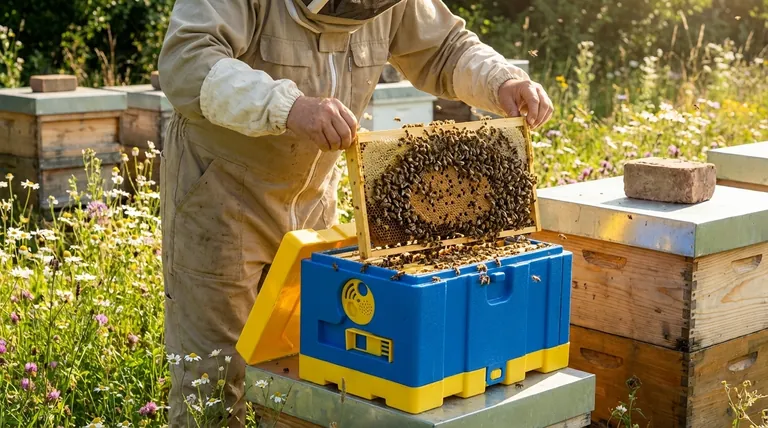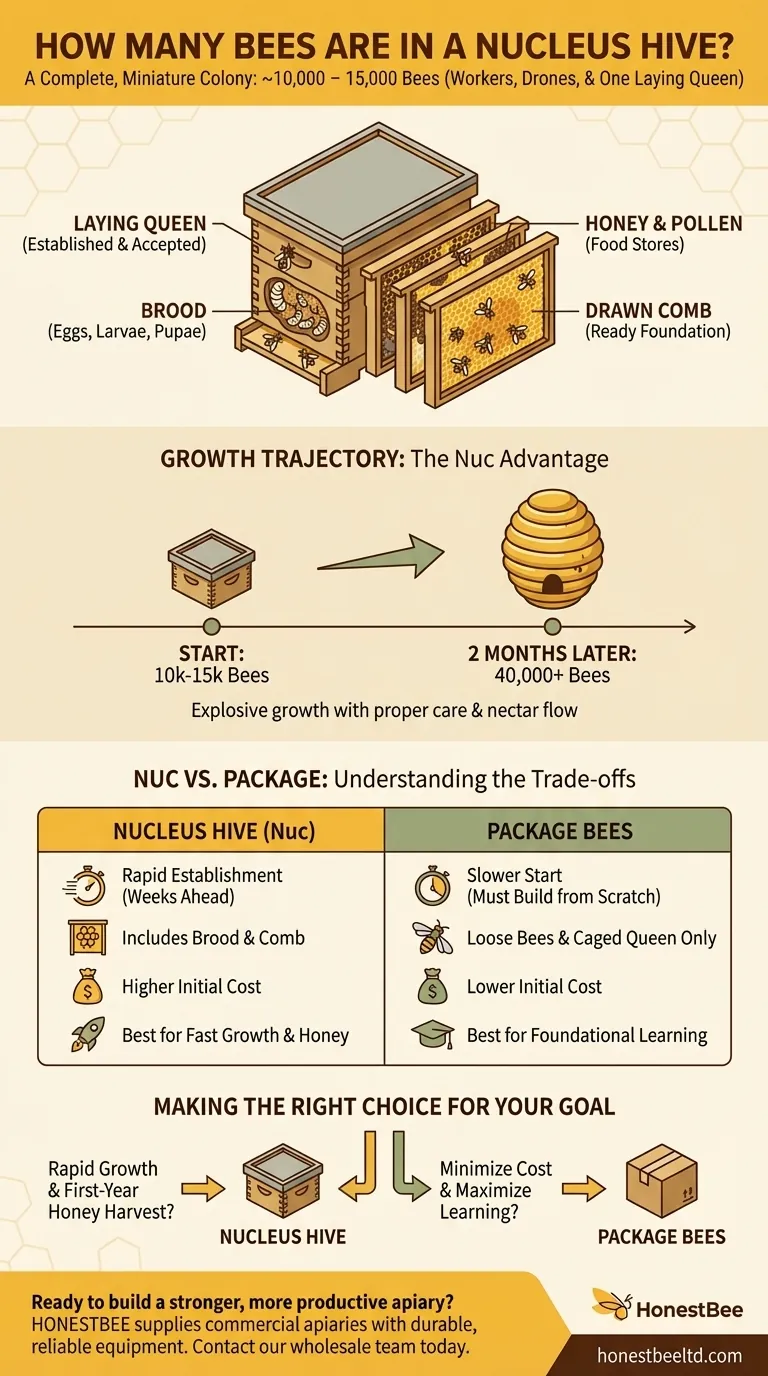A standard nucleus hive, or "nuc," contains approximately 10,000 to 15,000 bees. This count includes worker bees, drones, and one laying queen. A nuc is not just a random collection of bees; it's a complete, miniature colony ready for rapid expansion once installed in a full-sized hive.
The number of bees is less important than what they represent. A nucleus hive is a fully functional starter colony with an established queen, developing young (brood), and food stores, giving a beekeeper a significant head start.

What Defines a Nucleus Hive?
A nuc is designed to be a viable, self-sufficient colony from the moment you receive it. Its components are more critical than the exact bee population.
A Complete Social Structure
The key to a nuc is its established structure. It always contains a proven, egg-laying queen who is already accepted by the worker bees.
This established social harmony means the colony can focus immediately on growth rather than queen introduction and acceptance, a common hurdle with other methods.
Frames of Brood and Resources
A nuc typically consists of 4-5 frames. These frames contain everything a colony needs to thrive.
You will find frames with honey for energy, pollen for protein, and most importantly, brood of all ages—eggs, larvae, and capped pupae. The presence of brood ensures a continuous supply of new bees will emerge, fueling population growth.
The Purpose of a "Nucleus"
The name "nucleus" is intentional. It serves as the core unit from which a much larger colony will grow.
Its smaller size makes it easier to manage and transport. The bees are already working together on drawn comb, giving them a foundation to build upon instantly.
The Growth Trajectory of a Nuc
The initial 10,000 to 15,000 bees are just the starting point. The real value of a nuc is its potential for explosive growth.
From 10,000 to 40,000
With proper care and sufficient resources like nectar and pollen, a healthy nuc can easily grow to a population of 40,000 or more bees within two months.
This rapid expansion is possible because the queen has ample space to lay eggs once the nuc is transferred to a full-sized hive box.
Critical Factors for Success
The nuc's growth depends on external conditions. A strong nectar flow, favorable weather, and a pest-free environment are essential.
The beekeeper's role is to provide a suitable hive, feed the colony if natural resources are scarce, and monitor for any health issues.
Understanding the Trade-offs
When starting a new colony, a nuc is just one option. Understanding its advantages and disadvantages is key.
Nuc vs. Package Bees
The most common alternative is a package of bees, which is a screened box containing loose bees and a caged queen.
A nuc has a major advantage because it comes with drawn comb and developing brood. A package must start from scratch, drawing out wax foundation and waiting for the first generation of new bees to emerge, setting them back several weeks compared to a nuc.
The Cost of a Head Start
This head start comes at a price. Nucleus hives are almost always more expensive than bee packages.
You are paying for the established comb, the brood, and the reduced risk of the colony failing to establish itself. For new beekeepers, this initial investment often pays for itself in colony health and success.
Making the Right Choice for Your Goal
Deciding on a nuc depends entirely on your priorities as a beekeeper.
- If your primary focus is rapid establishment and a higher chance of a first-year honey harvest: A nucleus hive is the superior choice due to its significant head start.
- If your primary focus is minimizing initial cost and you are willing to provide more intensive early-stage care: A package of bees may be a suitable alternative.
- If your primary focus is learning and observing a colony's entire development cycle from the very beginning: Starting with a package can be a more foundational educational experience.
Ultimately, a nucleus hive provides the most reliable and robust foundation for building a new, thriving bee colony.
Summary Table:
| Aspect | Nucleus Hive (Nuc) | Package Bees |
|---|---|---|
| Bee Population | 10,000 - 15,000 bees | ~10,000 bees (3 lb package) |
| Key Components | Laying queen, brood, honey, pollen, drawn comb | Loose bees & a caged queen |
| Establishment Time | Rapid (weeks ahead) | Slower (must build from scratch) |
| Best For | Reliable, fast growth & first-year honey | Lower initial cost & foundational learning |
Ready to build a stronger, more productive apiary?
Starting with a high-quality nucleus hive is the first step toward a thriving operation. At HONESTBEE, we supply commercial apiaries and beekeeping equipment distributors with the durable, reliable supplies needed for success—from nuc boxes and frames to full hive systems.
Let us help you establish and grow your colonies with confidence. Contact our wholesale team today to discuss your needs and explore our product catalog.
Visual Guide

Related Products
- 4 Frame Plastic Nuc Boxes for Beekeeping Bee Nuc Box
- HONESTBEE Professional Long Handled Hive Tool with Precision Cutting Blade
- Inner Beehive Cover for Beekeeping Bee Hive Inner Cover
- Modern Flat-Mount Hive Number Set for Beekeeping
- Professional Hive Front Entrance Bee Feeder
People Also Ask
- What are the benefits of maintaining a nuc in beekeeping? Gain Control and Resilience for Your Apiary
- What are nucleus colonies (nucs) and how do they compare to full-size Langstroth colonies?
- What should a healthy brood nest in a nuc look like? A Guide to Strong Colony Development
- What are some uses for a nucleus in beekeeping? A Guide to Apiary Growth and Resilience
- Why is a sound knowledge of beekeeping basics important when working with nuclei? Unlock Your Apiary's Full Potential



















